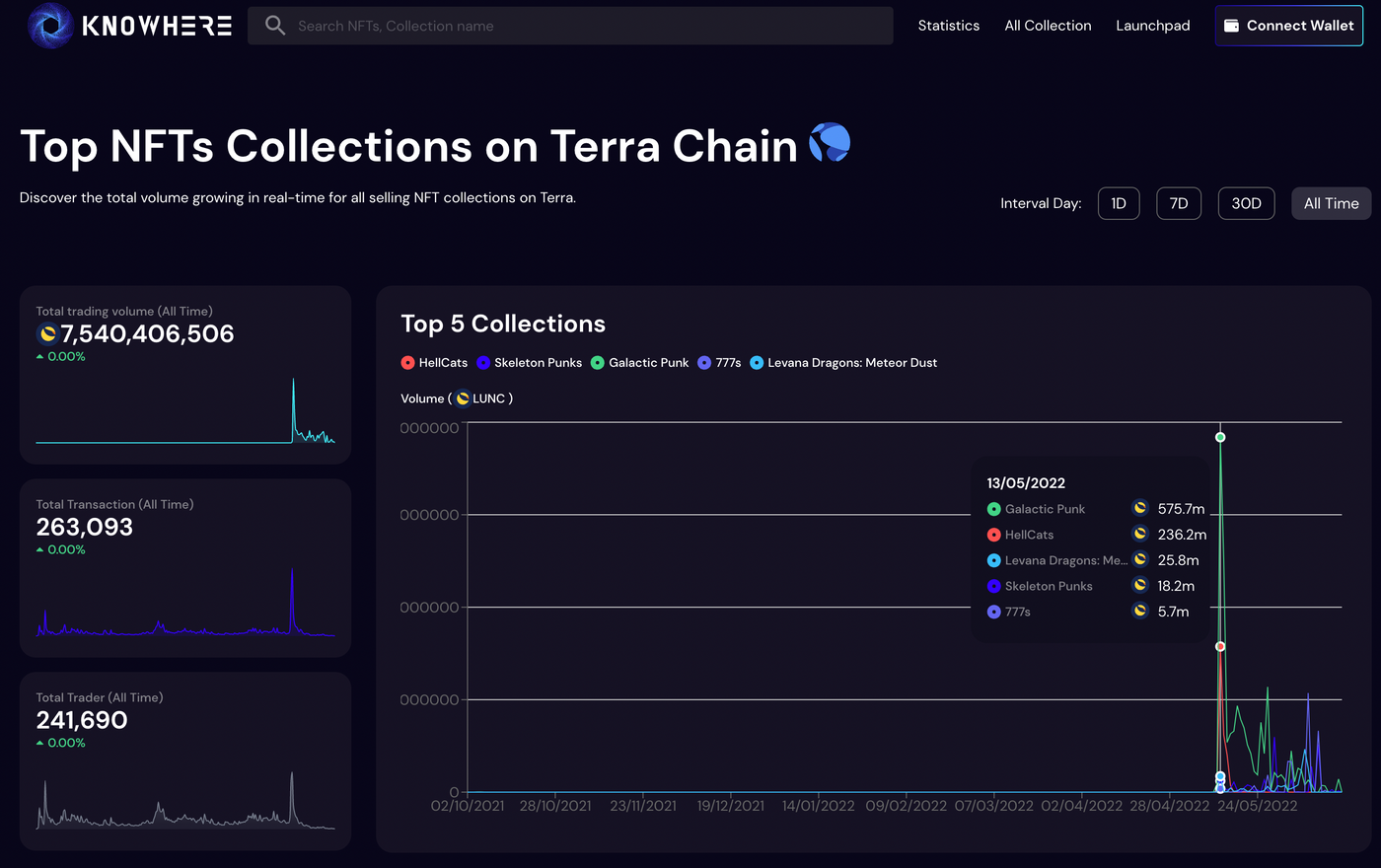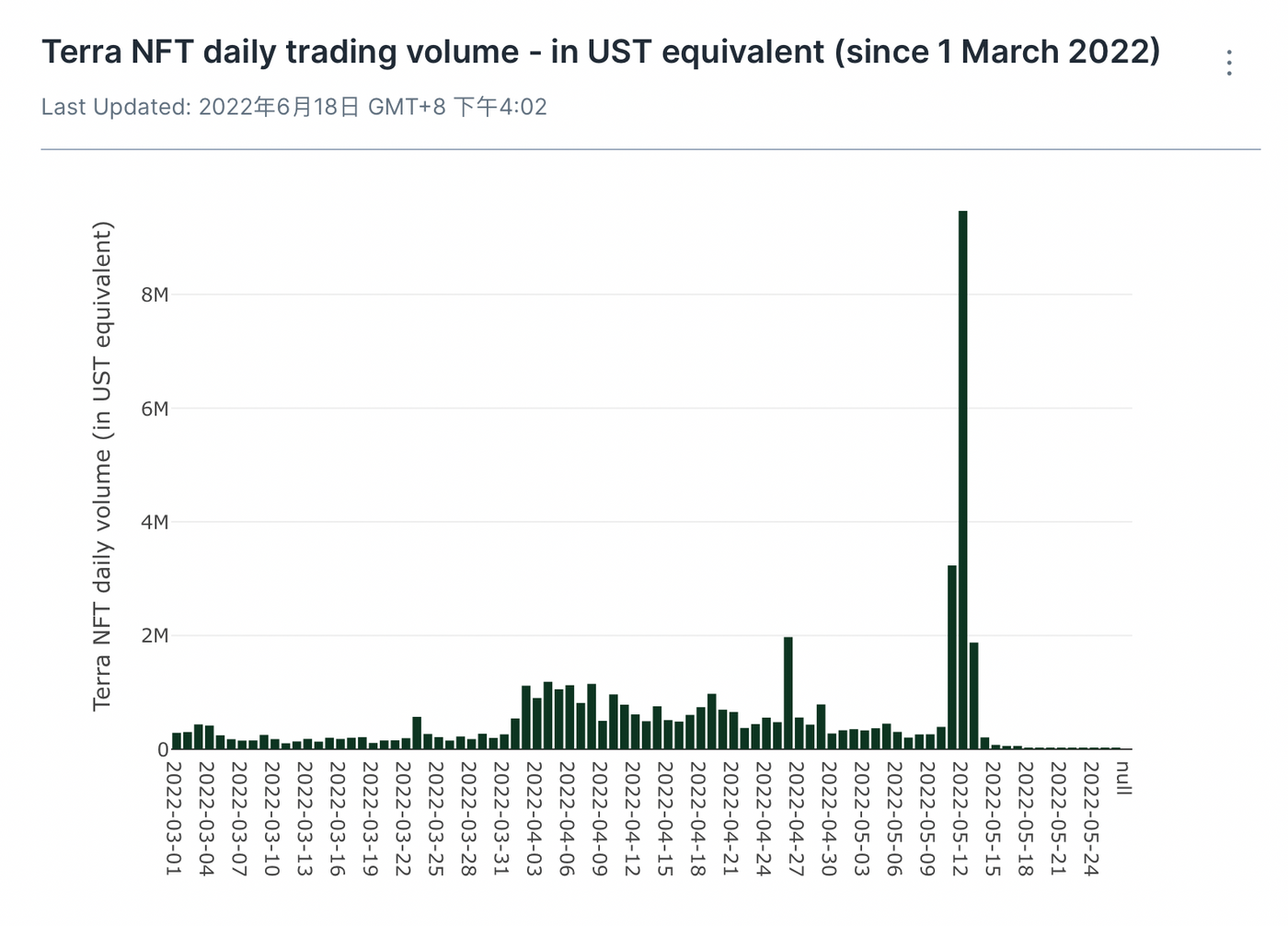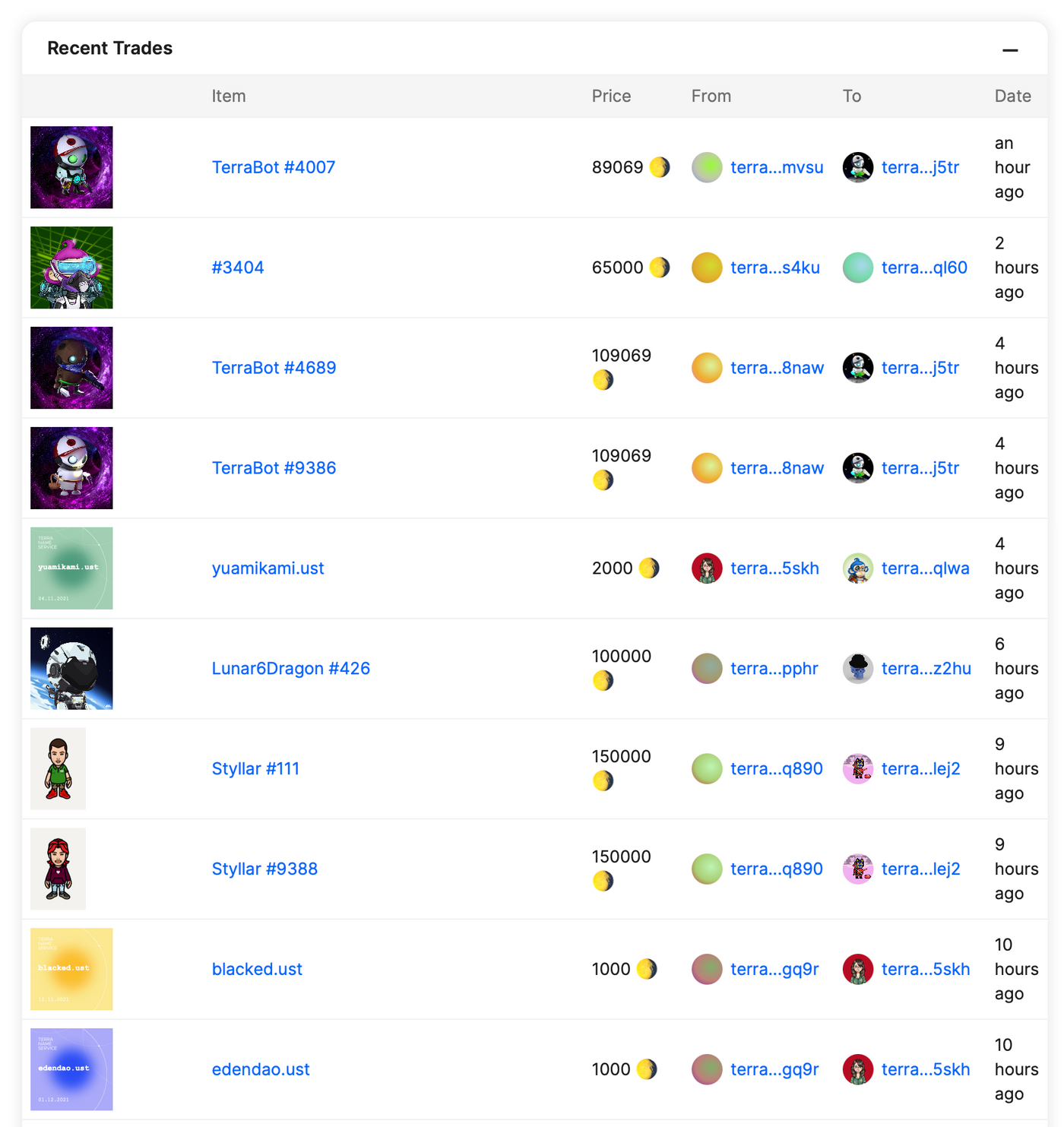NFT Story Collection: When the Earth is destroyed, will Terra NFT creators escape or be buried?
Today I want to imitate Blade Runner's cyborg Roy Batty's monologue in the rain, mix in a bit of digital prophet Kevin Kelly (KK), and maybe add a McDonald's hat to tell a story... the story of Terra NFT.
More than a month has passed since the largest stablecoin UST decoupling event in history, and a generation of dynasty Terra chain fell, and tens of billions of dollars were instantly empty. The Luna coin and the stablecoin UST issued by Terra are almost zero. Lunatics defends rights, admits admits, and die-hards believe that Terra will eventually rise again. Lunatics, lunatics, are the self-proclaimed names of Luna holders.
In the past month, the Cosmos galaxy multi-chain, which uses the same cross-chain protocol as Terra, has sunk like a serial ship on fire, and the entire cryptocurrency world has also shrunk dramatically. Many media reported sadly: "The bear market is here, and it's going to be long." In the chaos of the apocalypse, I bought 280,000 Luna coins with NT$400 and kept them on my body to be vigilant.
For Lunatics, the end has already come. So what happened to the NFT ecosystem on Terra? How do project owners and creators deal with this sudden tsunami? Can this incident give us a reference to those of us who are working hard in other chains? I backtracked from the community articles of Terra chain practitioners, platform parties, and project parties in the past month, and discussed them here.

Back to NFTs
So far, I think NFTs have only one function: pegging value to price. In the bull market, no matter how the project party and you are hyped, empowered, airdropped, and exchanged, they are ultimately tying a token to a price. In a bear market, no matter how miserable the price of NFT is, it is ultimately burdened with the value it has been given. Over time, spiritual values will emerge.
I think there are three kinds of tokens that are particularly resistant to time, namely art tokens, cultural tokens, and public welfare tokens. Because these tokens are quantified self-realization, allowing virtual spirits to be exchanged, we won't get used to it now, but in the future. Only with this infrastructure, the Anthropocene will eventually move towards a digital world, a world of video games, digital twins, and a global village.
But the value of NFT is linked to price, there are two basic premises, time and space . We need digital proof technology that exceeds human lifespan, and an exchange system that can instantly transcend human geography. The former is a blockchain, the latter is a cryptocurrency, and the two are actually two sides of the same coin. Only when the time span can be satisfied can spiritual value be believed; when the spatial span is satisfied, the price can be efficiently considered.
It should be noted here that NFT itself has no spiritual value. The so-called artistic context, cultural accumulation, or public welfare actions, these values are written into the token in digital form, or mounted in the storage system behind the token. . Therefore, when someone asks "NFT is/isn't art?", this question should be more accurately interpreted as "are these digital files linked behind NFTs art?", which brings us back to contemporary art vs. digital The context of art evaluation is not discussed in this article.
A small conclusion, the era of enlightenment has passed, and the attention bonus of issuing NFT to rub traffic has depreciated. Only by facing up to the technological invention behind NFT that breaks through the limitations of time and space can we more clearly know why we issued NFT.
NFT worker
I believe that NFT practitioners on different chains are working hard to practice the above ideals or fantasies. Whether it is an NFT platform operator, an NFT issuer, or even just a community manager, they all believe in the eternity and convenience of NFT.
But this is an emerging technology that still needs to be verified before it can travel through time and space, and Terra exploded last month, and the NFT above can't wait for eternity to come. To be honest, the sharp drop in the currency price has never shaken me, but the shutdown of the chain has scared me, because it denied that digital data can break the limitations of time and space, and the spiritual value cannot be compared to tokens, which destroys the issuer’s commitment to collectors. .
In the field of astronomy, witnessing the explosion of ancient galaxies tens of thousands of light-years away allows us to verify the latest theories; in the field of blockchain, a Terra crashed alive in front of our eyes, verifying how naive and immature NFTs are.
The death of the chain vs. the death of the platform
In 2022, the collapse of Luna and UST token prices caused Terra to hard fork into new chains, Terra 2.0 and Terra Classic. This is with the 2016 ether
The square rollback and the 2016 Bitcoin fork are not the same. Terra is already an ecosystem, and too many people rely on it for a living. The collapse of Terra and the hard fork caused a great shock to the NFT ecosystem, which may be more suitable for comparison with the Hic Et Nunc shutdown event of the Tezos chain in November last year.
In 2021, the Hic Et Nunc platform (HEN), which has been in operation for half a year and created a large amount of transaction volume, suddenly closed without warning. HEN is a platform loved by the art community, and its transaction volume even surpassed OpenSea, which accounts for 80% of the NFT transaction volume so far. . HEN's unannounced shutdown caused panic among creators on Twitter that day. However, the Tezos chain is still operating stably, so the closing of the site only affects the front-end web page display. The smart contract of HEN itself is not affected. The minting and listing are as usual, and the block chain will operate stably.
The response speed of the community was astonishing. Eight HEN mirror websites appeared in the week of closing the site to help creators and collectors continue to use HEN smart contracts. Today, half a year later, with the impact of the HEN closing event, the Tezos chain has grown into a more robust ecosystem. The original secondary market OBJKT has a larger transaction volume and provides minting and distribution services; mirror sites and communities use decentralized resolution to integrate a more powerful TEIA platform; the emerging platform Versum is born and becomes an alternative mainstream choice (Versum is an alternative mainstream choice due to Ukraine’s The rescue operation is well-known); on the contrary, the HEN authentic platform has been silently launched after a few months, but has lost loyal users.
For detailed articles, please refer to my work: NFT Story Collection: At this moment of disappearance, is it a saint or a traitor?
The Tezos NFT ecosystem thrives when one platform goes out of service; but this time the Terra NFT ecosystem isn't so lucky.
How does the Terra NFT ecosystem face the collapse?
First of all, I am not that familiar with the Terra NFT ecosystem, and I have a simple understanding due to research needs in the past. In fact, before the crash, Terra had a daily trading volume of tens to millions of dollars. The Terra NFT ecosystem is still dominated by avatar projects (commonly known as PFP projects), and many platforms themselves provide Launchpad services, such as Random Earth, One Planet, etc.
PFP projects are like pioneer plants, which first multiply when each chain develops to support the NFT period. This phenomenon occurs whether it is in Yuan Zu's Ethereum, or Solana, Cosmos, and IOTA. First, the PFP community, and then the NFT community based on individual creators slowly emerged. Tezos is special in this regard.
When the Terra ecosystem collapsed, there were immediately visible dangers to NFTs, starting with the decoupling of value from price. This phenomenon can be said to be some kind of hyperinflation. The event occurred from 5/11 to 5/12, when UST decoupling and Luna collapsed, and the transaction volume on the NFT platform increased dramatically. Terra's largest NFT platform, Random Earth, has a daily transaction volume of nearly 10 million Luna. But this is just an illusion. Random Earth then suspended trading, and later reopened the old chain for trading on 5/28. You can find that the price of NFT above casually jumped up to hundreds of thousands of Luna, but the transaction volume was almost zero, and there was no consensus in the market.

And Terra, like the Kuomintang government, exchanged old Taiwan dollars for new Taiwan dollars. Terra also released a new Luna, renaming the old Luna Luc (Luna Classic), and airdropped it on the new chain according to a certain percentage, which is also about tens of thousands for one. Collectors have lost confidence in the collection price of NFTs, and the spiritual value behind them is no longer important.
Next, will the NFT minted by smart contracts cause security risks due to the collapse of the currency price and the slowdown of miners, such as classic blockchain propositions such as 51% attack. And if the chain really stops completely, its NFT loses its function, because the block will never grow again, and there is no possibility for the token to be traded. This is not a state that mirror sites, new services can handle.
Third, for the PFP project party, when the tokens in hand return to zero, does it mean that the entire project cannot be put into operation? The community value of NFT has disappeared, and since then it really only has the "spiritual" value of pictures. And the last bit of spiritual value has also lost the possibility of exchange because the transaction is stopped.

After the crash?
With Terra founder Do Kwan announcing the arrival of Terra 2.0, how should NFT projects and platforms respond?
Of course, most of the project parties have disappeared, and I hope they are well. The platform side responded with a big move. The names of the top two NFT platforms suggest their direction. Randon Earth and Knowwhere announced that they will work together with Terra, and will migrate to Terra 2.0. The NFTs on it will also be recognized by the new chain and remain the same. ; Luart has entered an indefinite maintenance state and is looking for other chains to migrate; and the emerging platform Talis already supports both Terra 1.0 and 2.0, although there is no transaction on it.
However, the most interesting platform is OnePlanet. OnePlanet has reached a strategic cooperation with the Ethereum side chain Polygon, launched Ark*One, and joined a group of NFT project parties to join the embrace of Polygon. OnePlanet even wrote the rules of teaching and warfare, as well as the most important decentralized cross-chain protocol, so that NFTs can smoothly migrate from Terra to Polygon (as shown in the picture). This reminds me of Liu Cixin's wandering earth, the sun is old and the earth must migrate to other galaxies. Under the crisis of survival, all kinds of survival tactics were quickly implemented and completed. OnePlanet's life-saving elixir is the cross-chain protocol.

In addition to the different directions of each NFT platform, NFT projects also have multiple ways out. In addition to projects such as DystopAI directly attached to the OnePlanet ship to Polygon, there are also many project parties who have moved to Solana or Polygon by themselves, such as Hell Cat, Derby Stars, Hellcat even made a mockery of Do Kwan's PFP complaining about this Chains inconvenience them. Of course, there are also the most loyal Lunatics, such as Terra's largest project party Galactic Punks or Terra Racers, etc. Punks has become huge enough to set up its own DAO and become a node verifier. The interest relationship may be too deep and must move forward with Terra.
Epilogue
Now that LUNC has become a memecoin, we must remember the ecosystem that once existed on top of memecoin.
If a public chain, its NFT ecosystem has evolved into a community with a single creator as the main body, or a community that has created a large collection of gold after repeated market evolution, when a public chain has everything to zero overnight, It's hard to imagine how much effort it would take to restore everything from the shock.
Terra NFT is only a half-year-old newborn. If the spiritual token is maintained for several generations, and the entire chain is shut down due to a black swan event, the works that have been handed down forever and their previous price records may no longer be meaningful.
The Terra event is a good opportunity for us to think about the difficulty and feasible methods of escaping from the public chain, and it also gives us a chance to think about the inheritance and stability of tokens on the scale of generations of humans. After all, no one knows, who will be the next public chain? In what year will it be? At that time, can the intertwined interest relationships on the public chain still be able to achieve "consensus" only on rollbacks and hard forks?
Finally, Su Shi has spoken to us a thousand years ago. When Lunatics is in a thousand miles together, don't forget the last sentence.
I wish people a long time.
I wish you all good health.
Like my work? Don't forget to support and clap, let me know that you are with me on the road of creation. Keep this enthusiasm together!












- Author
- More